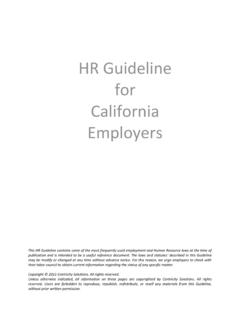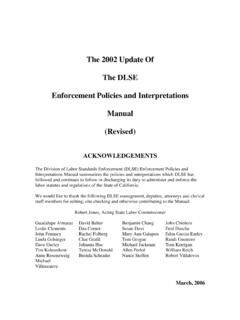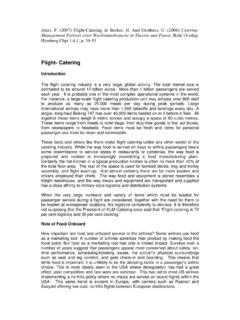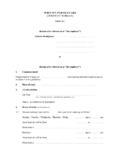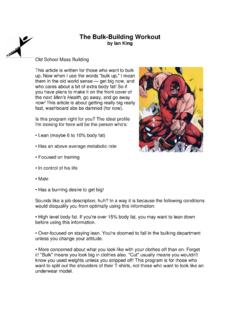Transcription of 17 Working hours, pause, periods of rest and overtime
1 17 THE LABOUR REGULATION 2000 Working hours, pause, periods of rest and overtime The Labour Regulation 2000 provides rules regarding among other things: Working hours, pause, periods of rest , labour in full continuous service, overtime , child-labour, night work, dangerous labour and labour of domestic personnel. The Labour Regulation 2000 is applicable to wage-earners earning less than the premium of the Sickness Insurance. Civil servants, sailors, stevedores and self-employed workers are not covered by the policies of the Labour Regulation. In applying the Labour Regulation the term wages refers to all income derived from work performed in the same business with the exception of payments made for overtime worked. On 1 August 2000, at the initiation of the Labour Regulation 2000 a difference has been made between schedule workers (these are employees Working at different periods (outside of regular office hours) and non-schedule workers.)
2 In the Labour Regulation different rules apply for these groups regarding Working hours, work schedules etc. In this folder we will pay special attention to the legal regulations regarding: Working hours, period of rest and overtime A. NON-SCHEDULE WORKERS Working hours Maximum 10 hours per day and a maximum average of 40 hours per week, calculated over a period of four weeks. Working hours including overtime amounts to a maximum of 50 hours per week calculated over a period of four weeks with the understanding that the total Working hours per day including overtime should not exceed 11 hours and the Working hours per week should not exceed 45 hours calculated over a 13 week period. Deviation is possible by collective labour agreement (CLA). Pause The period during which the employee has to work has to be interrupted for at least half an hour after five hours of work, overtime included.
3 periods of rest the period between 20:00 o clock at night and 7:00 o clock in the morning two time table free parts of the day (be they connected or not, example the entire Saturday or Saturday morning and Monday morning) Sundays Holidays B. SCHEDULE WORKERSJust as non-schedule workers, schedule workers are allowed to work 10 hours maximum beyond their regular weekly Working hours calculated over a period of four weeks. Working hours Maximum 10 hours per day and a maximum average of 45 hours per week, calculated over a period of four weeks. Working hours including overtime amounts to a maximum of 55 hours per week calculated over a period of four weeks with the understanding that the total Working hours per day including overtime should not exceed 11 The Working hours per week should not exceed 50 hours calculated over a 13 week period. Deviation is possible by collective labour agreement (CLA).
4 Pause the period during which the employee has to work has to be interrupted for at least half an hour after five hours of work, overtime included periods of rest Daily the period that lies before and after the Working hours according to his timetable, taking into consideration that his resting period per 24 hours (continuously) has to be (continuously) a minimum of 11 hours. This resting period may be reduced once every seven days to a minimum of eight hours; The weekly day off according to his time table (this has to be on a Sunday once every seven weeks) Once every week a part of a day prior to or after o clock at least five holidays per year. C. FULL CONTINUOUS SHIFT Labour in a continuous company is: labour in a company which is continuously being run during 24 hours a day 7 days a week, such as parts of the medical sector and the oil refinery.
5 Working hours maximum 10 hours per day and a maximum average of 45 hours per week, calculated over a period of four weeks. Working hours including overtime amounts to maximum 60 hours per week. Pause the employer has to grant the employee a pause of at least half an hour on the day on which the employee works more than 6 hours, unless the work does not allow this. periods of rest daily the hours between the end of one Working day and the beginning of the next with the understanding that the periods of rest per (continuously) 24 hours has to be at least 11 hours (continuously). This period of rest can only be shortened once in seven days to eight hours; the weekly day off according to his time table (which must be a Sunday at least once every thirteen weeks); at least five holidays per year. D. NIGHTSHIFT For employees who work according to a schedule between o clock and o clock, other than by way of overtime , different rules apply with regard to Working hours, periods of rest and number of nightshifts.
6 overtime AND overtime COMPENSATIONP lease note: Part-timers are only entitled to overtime compensation in cases where, had they been full-time workers; they would have been entitled to overtime compensation (example Working on a rest day/ Sunday or holiday and so on). This is different if parties, if legally permitted, make other arrangements. There is overtime in the following situations: If the employee works during his period of rest If the employee works longer than the maximum period of labour per day or per week. Rules relating to overtime : If the employer calls upon the employee to work overtime during a day on which the employee is free according to his work schedule, then a minimum of three hours of overtime should be paid. If the labour hours per day inclusive the overtime is a minimum of ten hours, the employer is obliged to give the employee a hot meal or a financial compensation for a hot meal.
7 An instruction to work overtime has to be given by the employer to the employee as soon as possible. When instructing the employee to work overtime the employer has to take the interests of the employee into consideration. overtime COMPENSATION Parties can determine higher but also lower overtime percentages in a collective labour agreement. Situation Compensation (incl. wages) overtime during period of rest 150% Exceeding the maximum Working hours (per day or after four weeks) 150% overtime on a scheduled day off 175% overtime on a day of rest 200% overtime on an holiday 250% overtime in combination with night-time work (for schedule workers only) 175% Please note: the schedule worker who has to work according to his schedule on an holiday has to receive at least twice his wage (200%). overtime on an holiday is 250% (see table). Further, employee and employer may agree in writing that instead of paying overtime in money it is compensated completely or partially in days off (time-back) according to the above mentioned overtime percentages.
8 E. HORECA LEGISLATION As of 23 September 2000, exceptions apply for businesses in the hotel, restaurant and casino industry Working hours maximum 48 Working hours per week, calculated over a period of four weeks with the understanding that the Working hours per day do not exceed 10 hours. Working hours including overtime amounts to a maximum of 55 hours per week calculated over a period of four weeks with the understanding that the total Working hours per day including overtime should not be longer than 11 hours. the Working hours for the night-shift (if established by the worker s schedule that work is performed on or after hours or before 06:00 hours) are limited to maximally 8 hours per day excluding breaks. Pause the employer has to grant the employee a pause of at least half an hour on the day on which the employee works more than 6 hours, unless the work does not allow this.
9 periods of rest the day of rest must be a Sunday at least once every 13 weeks daily the hours between the end of one Working day and the beginning of the next with the understanding that the periods of rest per 24 hours will be at least (continuously) 11 hours. holidays overtime Work performed beyond the Working hours permitted per day or per week: 150% Work performed during the employee s valid day of rest or a holiday: 200% F. DOMESTIC PERSONNEL Working hours 11 hours maximum per day and 55 hours maximum per week Pause The employee should have at least half an hour pause after every 5 hours of work. periods of rest The hours between o clock and o clock are considered to be the resting period unless the labour relates to nursing which occurs between said periods . The employee has the right of one day of rest every seven days. holidays overtime Performing work beyond the Working hours permitted per day or per week: 150% Performing work during pause: 150% overtime during days of rest or holidays: 200% LEGAL ADMINISTRATIVE REQUIREMENTS Every business must have a list of employees visibly posted.
10 Labour list containing time tables for schedule workers must be sent to the Labour Affairs Agency. Upon request the employer is obliged to present a register of personnel. The employer must maintain a register of overtime and is obliged upon request to present same. SANCTONS The Labour Regulation 2000 stipulates stricter punishments than the former law and there in makes difference between felonies (wilful breaking of certain articles) and misdemeanour (none or partial compliance with injunctions, requirements or orders) Punishment for a felony: imprisonment of maximum 4 years and/or a fine of maximum Nafls. ,00, Punishment for a misdemeanour: imprisonment of a maximum of one year and/or a fine of a maximum of Nafls. ,00.





